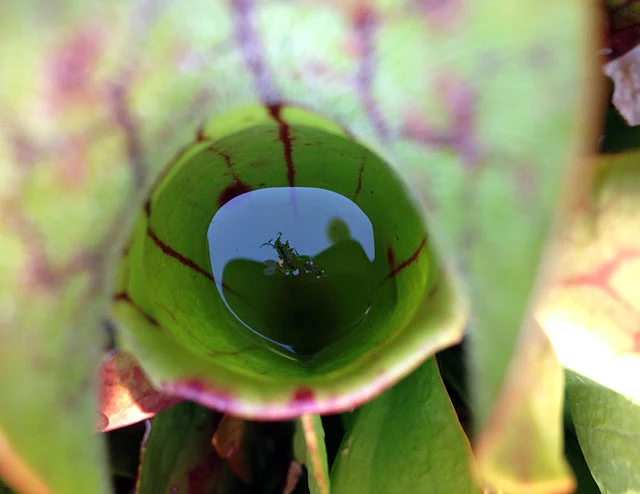Quoddy Bog
How many of us have explored a bog? The Irish landscape gave us the term we use often, but we barely appreciate its roots.
A bog like this one requires a boardwalk. There's hardly anyone light enough to avoid getting "bogged." This landscape expressed a surprising shift in scale unseen in other environments. At once you are viewing the trees, shrubs, and moss. Get closer, you see even more.
The dominant colors within the bog are crimson and chartreuse.
Ribs add rigidity to the rather phallic structures of Pitcher Plant, Sarracenia purpurea.
Hairs point downward on the interior throat, making it easy to enter, but hard to leave.
An ant investigates at its peril.
The Pitcher, like all pitchers, eventually fills with liquid -in this case, rainwater.
The trapped insect falls into the liquid, where it is digested by enzymes released by the plant.
Statuesque flower of the Pitcher Plant.
Seeds.
Sundew is another species of insect digesting plant.
There are two varieties of Sundew in the Quoddy bog. This one is known as the Round-leaved Sundew, Drosera rotundifolia.
Insects are drawn in by the sparkly, sticky fluid on the tips of hairs. Once there they become trapped and digested. The leaves do not close on the insect like the Venus Fly Trap.
In the areas where rain had ponded on the surface, the other Sundew.
Drosera intermedia, or Spatulate-leaved Sundew.
Which happened to be just about to flower, although just out of reach of my camera phone.
The dead sphagnum layered beneath the surface is several feet deep, is oxygen and nutrient poor, and highly acidic. There is no ground water in this substrate; the bog receives all its water from rain and dew alone. That these plants evolved the ability to ingest nitrogen, phosphorous, and other nutrients from insects is rather incredible.
There was some blueberry (and cranberry too).
Black Crowberry, or Empetrum nigrum, was abundant (edible fruit, none present).
The rubus-leafed plant to the upper left is called Baked-apple Berry, or Rubus chamaemorus. Yes, these berries are edible and, you guessed it, are said to taste like baked apples.
Up next -peat.

























The ponemah bog is near where my parents used to live and I loved visiting it every Thanksgiving. I miss it, now that they've moved. (Yes, yes, I know it's still there.) I cannot believe you got all those shots with your camera phone. Kudos.
ReplyDeleteOne day a real camera, Ellen, but thank you for noticing. Does the ponemah have a boardwalk so you can get close? Bogs truly are magical landscapes.
DeleteHi!
ReplyDeleteI am Tiffany Selvey, Talent Producer for Demand Media, the company that owns eHow.com, SFGate.com, and many others. I would love to talk to you about becoming on-screen talent! I'm a Master Gardener and I'm looking to collect a small group of folks who can encourage the world to garden. :) Please contact me at tiffany.demandmedia@gmail.com if you are interested.
Really stunning.
ReplyDelete